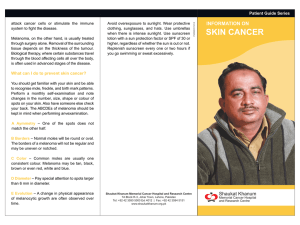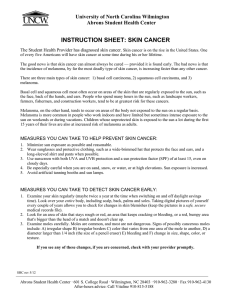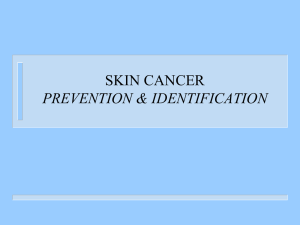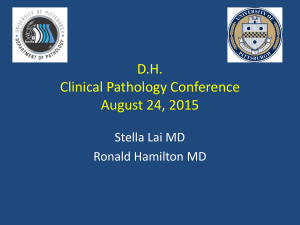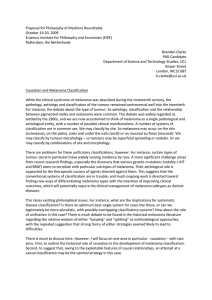File - scsc VCE Health & Human Development
advertisement
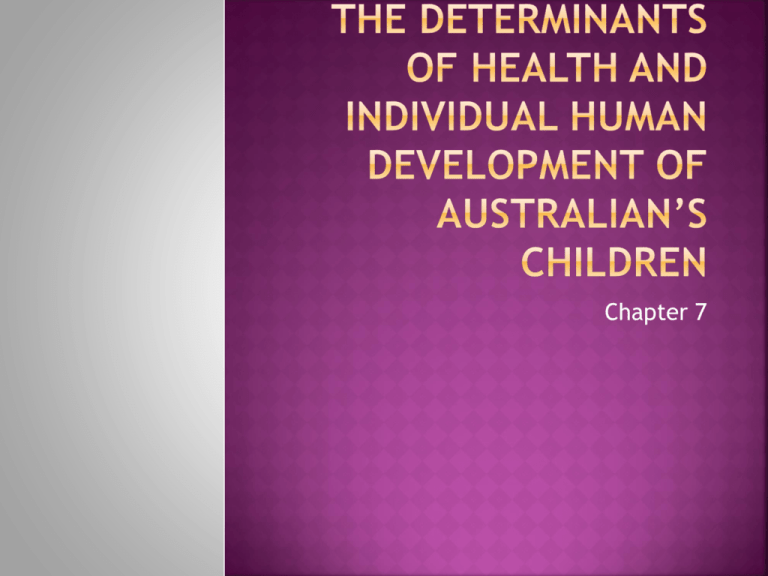
Chapter 7 Skin cancer is a major risk to human health and development to children and adults in Australia. Overexposure to the sun as a child can significantly increase the risk of developing eye and skin damage and skin cancer as an adult Sunburn is the reaction of exposure to UV radiation. Overexposure to the sun and sunburn can also increase the risk skin caners Preventative measures that can be taken include taking a ‘sun smart’ approach when out doors. The best way to be sun smart is to ‘slip on a t-shirt, slop on some sunscreen and, slap on a hat.’ In Australia, the risk of developing skin cancer from too much sun exposure needs to be balanced with the need to maintain adequate vitamin D levels. People who are vitamin D deficient are at risk of rickets (soft and weaken bones) The UV from the sunlight is required for the formation of vitamin D in the skin. It can also be found in small amounts in some food such as oil, fish, eggs and some dairy products. Vitamin D is important to the developing child because it helps the body to absorb calcium through the small intestine . Calcium is required for the ossification (hardening) of bones and teeth, and the functioning of muscles and nerves There are three types of skin cancer: basal cell carcinoma, squamous cell carcinoma and melanoma. Melanoma is the most dangerous form of skin caner. It has the potential to spread to other parts of the body. Melanoma is linked to the amount of lifetime exposure to the sun. Sun protection during infancy and childhood is vital for reducing the risk of melanoma in adulthood. Answer Test your knowledge questions 1-4 on page 223 and Apply you knowledge question 5. The Physical environment refers to the surroundings in which person lives in and the accessibility to resources such as housing, food, water, health services and recreational facilities . It also refers to the environmental conditions in which a child lives impacts on the individual health and human development. Ideally a house provides shelter, a clean place in which to live, and protects children form the outdoor environment, including any physical dangers. Not everybody has the ideal house and are forced to live overcrowding dwellings. Overcrowding causes further issues such as water supplies ( bathroom, kitchen, laundry, wastes disposals). These factors as well as living in close proximity can cause infections and infectious diseases to spread. Living in a low socio economic situation has been linked to a range of flow on effects. (see figure 7.31 P224) According to Kidsafe Victoria, half of the deaths and three out of 4 injuries in the 0-5 age group occur at home. Some of the major concerns in the home environment include: Drowning Access to medication and medical facilities Falls from playground equipment Falling from verandas and stairs Burns and scalds Choking Dog bites Research three of the mentioned concerns. Answer the following questions; What are the causes? What are the percentages of children in the 0-5 age group that face the concerns? How can the concerns be prevented? Fluoride is a natural mineral found in food, water, plants and toothpaste. The fluoridation of water involves adding fluoride to the public water supply to reduce tooth decay. Fluoride reduces the amount of acid that is produced and bacteria in the mouth. All capital cities in Australia has now has access to fluoridated water, with Brisbane being the last capital city to phase it in, in 2008. The consumption of fluoridated water, along with a good nutrition and appropriate oral hygiene, helps protect children’s teeth by reducing the risk of tooth dcay. Answer Test your knowledge questions 1-5 on page 227 and Apply you knowledge question 7. If you have finished all task please move onto chapter 7, 7.11. Read the information on page 228-229. Access to recreational facilities. Read the case study on page 229 and answer the 3 questions attached to it. Page 229 Test you knowledge 1-4
